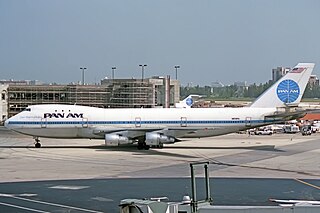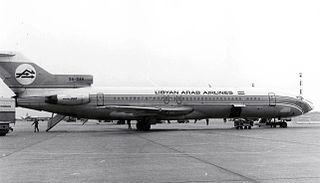
The Entebbe raid or Operation Entebbe, officially codenamed Operation Thunderbolt, was a 1976 Israeli counter-terrorist mission in Uganda. It was launched in response to the hijacking of an international civilian passenger flight operated by Air France between the cities of Tel Aviv and Paris. During a stopover in Athens, the aircraft was hijacked by two Palestinian PFLP–EO terrorists and two German RZ terrorists, who diverted the flight to Libya and then to Uganda, where they landed at Entebbe International Airport to be joined by other terrorists. Once in Uganda, the group enjoyed support from Ugandan dictator Idi Amin.
Egyptair is the state-owned flag carrier of Egypt. The airline is headquartered at Cairo International Airport, its main hub, operating scheduled passenger and freight services to 81 destinations in Africa, Europe, Asia, and The Americas. Egyptair is a member of Star Alliance.

EgyptAir Flight 648 was a regularly scheduled international flight between Athens Ellinikon International Airport (Greece) and Cairo International Airport (Egypt). On 23 November 1985, a Boeing 737-266 airliner, registered SU-AYH, servicing the flight was hijacked by the Palestinian terrorist organization Abu Nidal. The subsequent raid on the aircraft by Egyptian troops killed 56 of the 86 passengers, 2 of the 3 hijackers and 2 of the 6 crew, making the hijacking of Flight 648 one of the deadliest such incidents in history.

Pan Am Flight 73 was a Pan American World Airways flight from Bombay, India, to New York, United States, with scheduled stops in Karachi, Pakistan, and Frankfurt, West Germany.
Unit 777, also known as Task Force 777, is a tier two special force in the Egyptian Army, falling under the El-Sa'ka Force. They specializes in black operations, commando style raids, counterterrorism, executive protection, hostage rescue, irregular warfare, manhunting, and special operations in behind enemy lines. It was created in 1978 by the government of Anwar Sadat in response to concerns of increased terrorist activity following the expulsion of Soviet military advisors from the country by Sadat and his efforts to achieve peace with Israel.
This is a list of aviation-related events from 1976.
In December 1973, a terrorist group executed a series of attacks originating at Rome-Fiumicino Airport in Italy which resulted in the deaths of 34 people. The attacks began with an airport-terminal invasion and hostage-taking, followed by the firebombing of a Pan Am aircraft and the hijacking of a Lufthansa flight.

Libyan Arab Airlines Flight 114 was a regularly scheduled civilian flight from Tripoli to Cairo, through Benghazi, that was shot down in 1973 by Israeli fighter jets after it entered by mistake, due to a system malfunction, the airspace of Egypt's Sinai Peninsula – then under Israeli occupation – resulting in the death of 108 civilians.

Luxor International Airport is the main airport serving the city of Luxor, Egypt. It is located 6 km (4 miles) east of the city. Many charter airlines use the airport, as it is a popular tourist destination for those visiting the River Nile and the Valley of the Kings.

Lufthansa Flight 181 was a Boeing 737-230C jetliner named Landshut that was hijacked on 13 October 1977 by four members of the Popular Front for the Liberation of Palestine, who called themselves Commando Martyr Halima. The objective of the hijacking was to secure the release of imprisoned Red Army Faction leaders in German prisons. In the early hours of 18 October, just after midnight, the West German counter-terrorism group GSG 9, backed by the Somali Armed Forces, stormed the aircraft in Mogadishu, Somalia, with 86 passengers and four of the total five crew rescued. The rescue operation was codenamed Feuerzauber. The hijacking is considered to be part of the German Autumn. 3 hijackers and the captain were killed.

Sabena Flight 571 was a scheduled passenger flight from Brussels to Tel Aviv via Vienna, operated by the Belgian national airline, Sabena. On 8 May 1972, a Boeing 707 passenger aircraft operating that service, captained by British pilot Reginald Levy, DFC, was hijacked by four members of the Black September Organization, a Palestinian terrorist group. Following their instructions, Captain Levy landed the plane at Lod Airport. The hijackers demanded that Israel release Palestinian prisoners in exchange for the hostages. The standoff was ended by an Israeli commando raid in which all of the hijackers were killed or captured.

Benina International Airport serves Benghazi, Libya. It is located in the borough of Benina, 19 kilometres (12 mi) east of Benghazi, from which it takes its name. The airport is operated by the Civil Aviation and Meteorology Bureau of Libya and is the second largest in the country after Tripoli International Airport. Benina International is also the secondary hub of both Buraq Air and flag carrier, Libyan Airlines. As of 17 July 2014 all flights to the airport were suspended due to fighting in the area.

Air West Flight 612 was a scheduled domestic passenger flight operated by Air West between Khartoum and Al-Fashir, both in Sudan. On January 24, 2007, with 103 people on board, the flight, operated by a Boeing 737, was hijacked shortly after takeoff by a male individual. The plane landed safely at N'Djamena, Chad, where the hijacker surrendered.

Singapore Airlines Flight 117 was a Singapore Airlines flight that was hijacked en route by four Pakistani terrorists on 26 March 1991.
On 19 February 1978, Egyptian special forces raided Larnaca International Airport near Larnaca, Cyprus, in an attempt to intervene in a hijacking. Earlier, two assassins had killed prominent Egyptian newspaper editor Yusuf Sibai and then captured as hostages several Arabs who were attending a convention in Nicosia. As Cypriot forces were trying to negotiate with the hostage-takers at the airport, Egyptian troops began their own assault without authorization from the Cypriots. The unauthorized raid resulted in the Egyptians and the Cypriots exchanging gunfire, killing or injuring more than 20 of the Egyptian commandos. As a result, Egypt and Cyprus severed political ties for several years after the incident.

Alyemda, internationally known as Democratic Yemen Airlines or just Yemen Airlines, was the national airline of South Yemen. It was established at Aden on 11 March 1971 after nationalizing Brothers Air Services (BASCO) which was a private company owned by the Baharoon brothers. It operated a network of flight routes throughout Africa and the Middle East, with its hub at Aden Airport, the former Khormaksar Air Force Base. Its head office was in the Alyemda Building in Khormaksar, Aden.

The Achille Lauro hijacking took place on 7 October 1985, when the Italian ocean liner MS Achille Lauro was hijacked by four men representing the Palestine Liberation Front (PLF) off the coast of Egypt, as she was sailing from Alexandria to Ashdod, Israel. A 69-year-old Jewish American man in a wheelchair, Leon Klinghoffer, was murdered by the hijackers and thrown overboard. The hijacking sparked the "Sigonella Crisis".

Israel–Libya relations describes the relations between Israel and Libya. While there have been no formal diplomatic agreements between Israel and Libya since Libya's independence, there have been some notable events and developments in their relationship over the years. One of the main reasons for Libya's antagonism towards Israel has been its support for the Palestinian cause. Libya, under the rule of Muammar Gaddafi, was a staunch supporter of the Palestinian cause and provided aid and support to various Palestinian militant groups.













